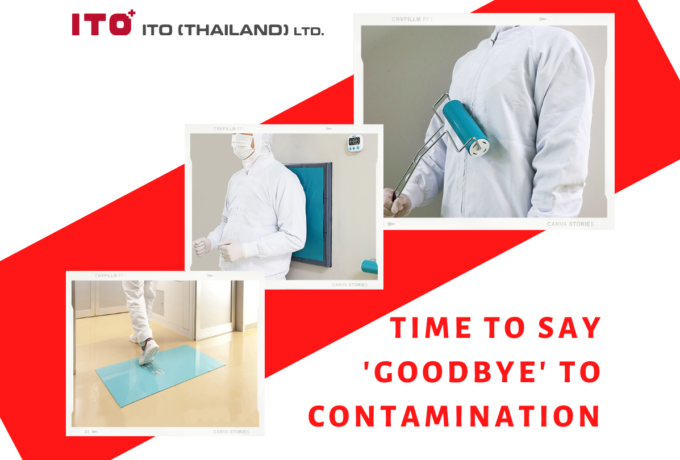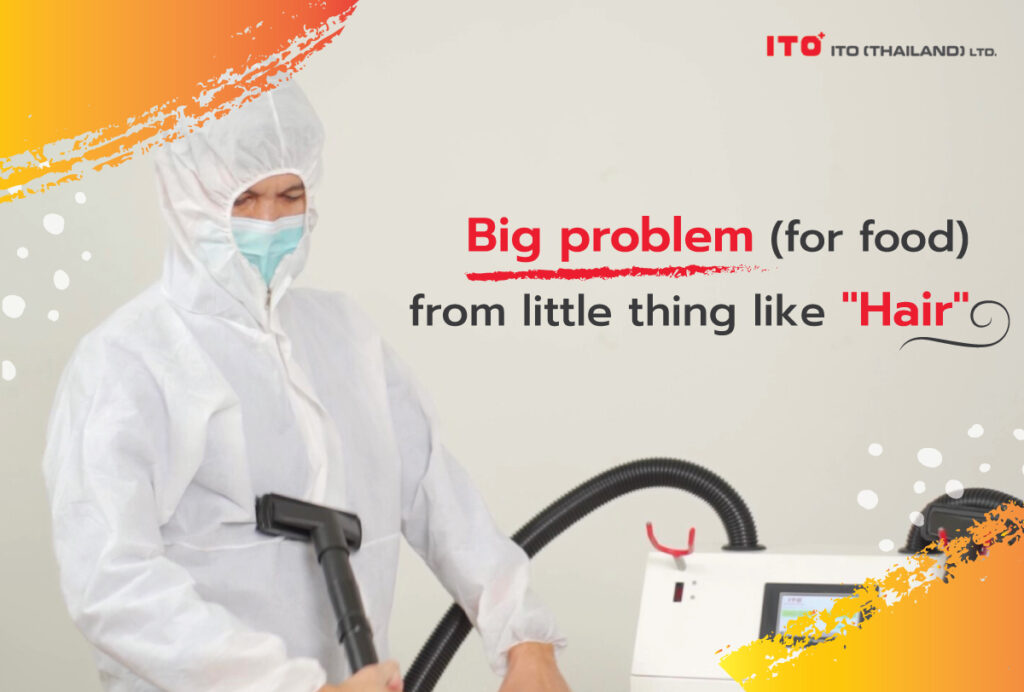ITO Thailand Hygiene Blog
Contamination of hair shafts/hairs in food
Contamination caused by the workers could be pieces of clothing and equipment such as scraps of gloves, thready waste, shoddy, buttons and jewelries that the workers breach the rules and bring into the production area. However, the most common contamination and the hardest to control is contamination from the bodies of the workers such as hair shafts, hairs, beards, dandruff, skin debris, secretions; for example, sweat, snot, saliva, nail dirt, blood and scabs including chemicals from products used by the workers such as shampoo, conditioner, perfume, nail polish, cigarette soot, etc. These contaminations can be prevented by both setting the rules, strictly following the rules and closely monitoring with supervision such as prohibiting the wearing of jewelries or other objects that may contaminate the production area, prohibiting the worker with open wound from working in high-risk areas, cutting nails, tying hair, refraining from painting nails, refraining from smoking, etc., as well as, providing supportive supplies and facilities sufficient to the workers such as coloured band-aids that are clearly seen (Blue band-aids are usually provided in a food plant) or metal detectors, face masks, hairnets, gowns or aprons, arm sleeves, boots, lockers and sinks. In case of a large plant or having a lot of workers, cleaning tools may be provided to clean the worker uniforms such as boot washers, industrial washing machines, industrial clothes dryers, disinfectant generators, etc.
Contamination of hair shafts/hairs and its effects
The most common contamination is hair shaft or hair contamination (moustache, beard, arm hair, nose hair) causing a consumer experiencing such contamination likely to feel bad due to the hair shaft or hair is usually big and can be easily seen with naked eyes; especially in nowadays social media, the photos of contaminated product can be spread quickly. In case of long hair, the consumer may be physically harmed such as getting stuck in the throat and choking. Besides, the chemical contamination (shampoo, conditioner, hair dye) and dirtiness, such as bacteria (Staphylococcus aureus), sebaceous gland sebum, dandruff flakes and fungi, may enable or cause other foodborne diseases as well.
Prevention of contamination
Usually, a human will shed averagely 100-150 hairs a day [1] or an average of 33-50 hairs per shift (8 hours). The more workers are, the higher risk of contamination is. Besides, the types of food products or the production processes also affect the contamination; for instance, food mixing method or heating in a closed container; sifting and filtration processes will help reducing the risk of contamination while the hand production processes, such as threshing flour, stirring the product in the pot, meat trimming, etc., sometimes are not avoidable. Therefore, the use of supportive gears such as hairnets, masks, arm sleeves or long-sleeved uniforms and gloves can help reducing the chances of hair shaft or hair contamination. In addition, elimination of hair shaft or hair shedding before entering into the production area; for example, using paper rollers or reusable glue rollers, collecting hair strands from shoes with dust trap mats, using an air blowing chamber and the vacuum cleaners, etc., together with setting the strict rules for the workers to strictly use these gears or setting the using time, such as setting a timer, counting the use and tearing off the roller’s adhesive pads, using a device to count duration of using roller, etc., will increase the efficiency of risk of contamination reduction and also raise the standard of plant cleanliness.
Technology related to prevention of hair shaft/hair contamination
Nowadays, the technology to prevent contamination has been greatly developed, especially the dust cleaner to clean dust and hair from ITO Thailand who developed an automatic cleaner to suck and collect hair shafts, hairs and dust that stick to clothes by using vacuum force to pull dust and hair with suction power without touching the hair directly, unlike a conventional paper roller, due the suction can pull the hair and dust around the area as well. The collected hair and dust will be stored in the filter bag and can be easily thrown away. Besides, this dust cleaner can be used continuously and conveniently because no roller adhesive pad is required to be torn off during use. Also, its suction power consistently pulls the dust and hair instead of relying on the stickiness of a conventional glue roller.
Additionally, the dust cleaner is also equipped a system of countdown timer and counting the number of uses enabling the workers to optimize the use with full efficiency including storing the daily usage data as data files imported into the computer for monitoring the plant cleanliness or retrieving the usage data during facing contamination problems as well.
For further information about dust cleaner, please contact us at click here
Reference:
1.Poonia, K., Thami, G. P., Bhalla, M., Jaiswal, S., & Sandhu, J. (2019). NonScarring Diffuse Hair Loss in Women: a Clinico‐Etiological Study from tertiary care center in North‐West India. Journal of cosmetic dermatology, 18(1), 401-407.
Related Post
-

Liquid nitrogen in food industry
You maybe have heard that liquid nitrogen can rapidly freeze the food, haven’t you? And what are its advantages and benefits? Let's get to know the liquid nitrogen in food industry with ITO (Thailand).
-

Ultrafine bubble (UFB) technology (Part 2)
The previous content has discussed the benefits of the ultrafine bubble technology in agriculture, livestock, and fisheries, cleaning raw materials and various surfaces. Today, we will continue to learn about the use of the ultrafine bubble technology in food production processes and waste management from the food industry and how to create these tiny gas bubbles.
-

Ultrafine bubble (UFB) technology (Part 1)
Simple bubbles when transformed into the micro-nano level can do more than you think. Let's learn about the technology of these tiny bubbles and their application in the food industry with ITO (Thailand).
-

Frozen food storage management
Freezing is a method of food preservation commonly used in food that goes bad quickly such as ready-to-cook fresh food, ready meals, or foods in which nutritional values decay easily, or have substances that are sensitive to temperature, light, oxygen, etc. Freezing uses a principle of quickly solidifying water in the products, making the molecules of the substances unable to react to one another, thus the foods last longer. It also suppresses the growth of microorganisms and kills parasites. For instance, USFDA suggested controlling parasites in fish consumed raw such as sushi and sashimi by freezing the fish at the minimum of 20 degrees Celsius for 7 days or stored at -35 degrees Celsius for 15 hours to control parasites in fish (conditions may depend on the size of the fish as well).
-

Boot Cleaner
Pay attention to the hygiene of the footwear for good hygiene in the food industry
-

Innovation for sustainable physical contamination prevention
It is known that external impurities pose a food safety risk. One of the main channels of contamination is the presence of humans as a carrier of dust and dirt into the production or high-risk areas, causing dirt, germs, or foreign matters to contaminate food and harm consumers.










